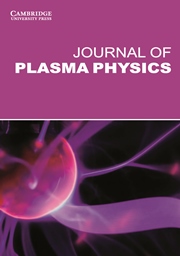Crossref Citations
This article has been cited by the following publications. This list is generated based on data provided by
Crossref.
Bader, A.
Faber, B. J.
Schmitt, J. C.
Anderson, D. T.
Drevlak, M.
Duff, J. M.
Frerichs, H.
Hegna, C. C.
Kruger, T. G.
Landreman, M.
McKinney, I. J.
Singh, L.
Schroeder, J. M.
Terry, P. W.
and
Ware, A. S.
2020.
Advancing the physics basis for quasi-helically symmetric stellarators.
Journal of Plasma Physics,
Vol. 86,
Issue. 5,
Kruger, Thomas G.
Zhu, C.
Bader, A.
Anderson, D. T.
and
Singh, L.
2021.
Constrained stellarator coil curvature optimization with FOCUS.
Journal of Plasma Physics,
Vol. 87,
Issue. 2,
McGreivy, N.
Hudson, S.R.
and
Zhu, C.
2021.
Optimized finite-build stellarator coils using automatic differentiation.
Nuclear Fusion,
Vol. 61,
Issue. 2,
p.
026020.
Henneberg, S. A.
Hudson, S. R.
Pfefferlé, D.
and
Helander, P.
2021.
Combined plasma–coil optimization algorithms.
Journal of Plasma Physics,
Vol. 87,
Issue. 2,
Hegna, C.C.
Anderson, D.T.
Bader, A.
Bechtel, T.A.
Bhattacharjee, A.
Cole, M.
Drevlak, M.
Duff, J.M.
Faber, B.J.
Hudson, S.R.
Kotschenreuther, M.
Kruger, T.G.
Landreman, M.
McKinney, I.J.
Paul, E.
Pueschel, M.J.
Schmitt, J.S.
Terry, P.W.
Ware, A.S.
Zarnstorff, M.
and
Zhu, C.
2022.
Improving the stellarator through advances in plasma theory.
Nuclear Fusion,
Vol. 62,
Issue. 4,
p.
042012.
Giuliani, Andrew
Wechsung, Florian
Stadler, Georg
Cerfon, Antoine
and
Landreman, Matt
2022.
Direct computation of magnetic surfaces in Boozer coordinates and coil optimization for quasisymmetry.
Journal of Plasma Physics,
Vol. 88,
Issue. 4,
Wright, A.M.
Kim, P.
Ferraro, N.M.
and
Hudson, S.R.
2022.
Modelling the nonlinear plasma response to externally applied three-dimensional fields with the Stepped Pressure Equilibrium Code.
Journal of Plasma Physics,
Vol. 88,
Issue. 5,
Bindel, David
Landreman, Matt
and
Padidar, Misha
2023.
Understanding trade-offs in stellarator design with multi-objective optimization.
Journal of Plasma Physics,
Vol. 89,
Issue. 5,
Landreman, Matt
Hurwitz, Siena
and
Antonsen, Thomas M.
2025.
Efficient calculation of self magnetic field, self-force, and self-inductance for electromagnetic coils with rectangular cross-section.
Nuclear Fusion,
Vol. 65,
Issue. 3,
p.
036008.
Huslage, Paul
Paul, Elizabeth J.
Haque, Mohammed
Gil, Pedro F.
Foppiani, Nicolo
Smoniewski, Jason
and
Stenson, Eve V.
2025.
Strain optimisation for ReBCO high-temperature superconducting stellarator coils in
SIMSOPT
.
Journal of Plasma Physics,
Vol. 91,
Issue. 2,
Baillod, A.
Paul, E.J.
Rawlinson, G.
Haque, M.
Freiberger, S.W.
and
Thapa, S.
2025.
Integrating novel stellarator single-stage optimization algorithms to design the Columbia stellarator experiment.
Nuclear Fusion,
Vol. 65,
Issue. 2,
p.
026046.
Hammond, K.C.
2025.
A framework for discrete optimization of stellarator coils.
Nuclear Fusion,
Vol. 65,
Issue. 4,
p.
046012.
Tomassetti, Giordano
2025.
Direct and surrogate optimization in applied superconductivity: state of the art, perspectives and challenges.
Superconductor Science and Technology,
Vol. 38,
Issue. 7,
p.
073001.
Kruger, T.G.
Martin, M.F.
and
Gates, D.A.
2025.
Coil optimization methods for a planar coil stellarator.
Nuclear Fusion,
Vol. 65,
Issue. 2,
p.
026051.
Nie, Xianyi
Peng, Jianlin
Xie, Yidong
Yu, Guodong
Liu, Ke
and
Zhu, Caoxiang
2025.
FOCUS-HTS: a new stellarator coil design code for three-dimensional high-temperature superconducting magnets.
Nuclear Fusion,
Vol. 65,
Issue. 8,
p.
086008.

